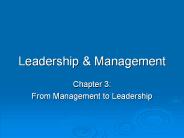LEADERSHIP - PowerPoint PPT Presentation
1 / 13
Title:
LEADERSHIP
Description:
style / behavioural theories try to identify the ideal style of leaders behaviour ... popularity and prestige, sociability, social participation, tact, diplomacy ... – PowerPoint PPT presentation
Number of Views:33
Avg rating:3.0/5.0
Title: LEADERSHIP
1
- LEADERSHIP
- Leadership theories fall into 3 categories
- trait theories look for the ideal person
- style / behavioural theories try to identify the
ideal style of leaders behaviour - contingency / situational theories argue that the
ideal style and the best person to play the
leadership role rely on the situation
2
- TRAIT THEORIES
- Argue that leaders are born not made
- Try to identify the characteristics / traits
required of an individual in order to be an
effective leader - Some theories
- R.M. Stogdill (1948)
- 5 physical traits (eg energy, appearance, height)
- 16 personality traits (eg adaptability,
enthusiasm) - 4 intelligence and ability traits (eg above
average IQ) - 6 task related traits (eg persistence,
initiative) - 9 social traits (eg good interpersonal skills)
3
- E.E. Ghiselli (1963)
- found significant correlations between leadership
effectiveness and - intelligence
- supervisory ability
- initiative
- self-assurance
- individuality
- K. Davis (1972) found effective leaders to have
- above average intelligence
- social maturity
- high achievement drive
- interest in people
4
- The most researched traits
- Intelligence
- judgement, decisiveness, knowledge, speech
fluency - Abilities
- ability to enlist co-operation, co-operativeness,
popularity and prestige, sociability, social
participation, tact, diplomacy - Personality
- adaptability, alertness, creativity, personal
integrity, self-confidence, emotional balance and
control, independence
5
- CONCLUSIONS
- While undoubtedly having some merit, trait
theories went out of fashion as - each study seems to identify different traits
(over 2000 identified in the literature) - no indication is given as to how much of the
trait is required - not all effective leaders possess the required
traits - many non-leaders possess some or all of the
traits - many of the traits are really just patterns of
behaviour expected from leaders (eg use of
initiative) so - did these people become leaders
because of the trait or was it developed
subsequently? - if the trait theories are correct, how come
leadership training can be so effective?
6
STYLE THEORIES
- Huneryager and Heckman (1967)
- dictatorial
- autocratic
- democratic
- laissez-faire
- Likert
- exploitive authoritative
- benevolent authoritative
- consultative authoritative
- participative group management
7
UNIVERSITY OF MICHIGAN STUDIES
- Commenced under the guidance of Likert
- Involved the analysis of a large number of
effective and ineffective work groups - The leadership style associated with each group
was examined - 2 styles identified
- employee centred - behaviours directed towards
the social and emotional needs of group members - production centred - behaviours directed towards
task accomplishment - Conclusion groups with employee centred leaders
outperform others
8
UNIVERSITY OF OHIO STUDIES
- Similar study identified -
- initiating structure leaders (task centred)
- consideration leaders (employee centred)
- Conclusion
- no one style of leadership can be said to be most
effective - which is most effective depends on
the situation
9
CONTINGENCY THEORIES
- Origins - the behaviour and trait theories
- Propose - there is no universally best style
also, leadership is not dependent on the
characteristics of the leader - IE leadership is situational the most effective
person and appropriate style of behaviour will
depends on - - leaders personality
- relationships between the leader and the led
- the nature of the task
- work conditions
- leaders position power
- safety and control requirements
- skill, experience and qualifications of the
leader and the led
10
Fiedlers Theory
- Based on
- assessment of leadership style and
- assessment of the situation
- Leaders style assessed by the Least Preferred
Co-worker technique - Situation assessed in terms of - leader
position power - task structure -
leader-member relations
11
- Very favourable situations everyone knows what
to do relationships are good (employees are
highly motivated) therefore - the leader does
not have to engage in lengthy human relations
exercises - a simple task focus is all that is
required - Very unfavourable situations little structure
(ie task focus is needed) relations are poor
(relationship focus will not work) therefore - a
human relations approach will not work, and
leader is left with no option but a task focus - Intermediate everyone has a reasonable idea what
to do and relationships are quite good by
adopting a relationship approach the leader can
bring about a significant increase in motivation,
leading to improved performance
12
- HERSEY AND BLANCHARDS SITUATIONAL THEORY
- A contingency theory which focuses on the
followers as the central variable - Identifies 4 classes of followers (4 maturity M
levels) - M1 typically new recruits lacking both
confidence (motivation) and ability - M2 by this stage, the subordinates still lack
the required technical expertise but have now
been socialised as part of the organisation
motivated, but unable - M3 have by now acquired all the necessary
skills, but motivation has become an issue - M4 followers who are both motivated and able
13
- Adopting the same two dimensions of leader
behaviour as other researchers, Hersey and
Blanchard argue that leaders can move along both
dimensions simultaneously, resulting in four
styles - TELLING characterised by a strong task emphasis
and low relationship emphasis suitable for M1
followers - SELLING strong emphasis on both the task and the
people suitable for M2 - PARTICIPATING low task emphasis and strong
relationship emphasis suitable for M3 - DELEGATING little emphasis on either - the group
is simply left to get on with the job suitable
for M4































